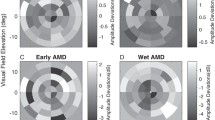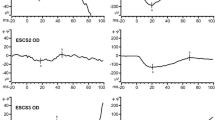Abstract
We describe three patients with central areolar choroidal dystrophy whose electroretinograms (ERGs) and pattern visually evoked cortical potentials (VECPs) confirmed their macular dysfunction. Visual fields measured by Goldmann perimetry showed central relative scotomata corresponding to a dystrophic lesion. Dark adaptation curves were slightly abnormal either in the first curve or in the second curve, depending on the visual acuity. Color vision was disturbed irregularly. Fluorescein angiography revealed a loss of the choriocapillaries, and a hyperfluorescent border outlined the dystrophic lesion.
Single-flash dark-adapted ERGs and scotopic ERGs were almost normal, while photopic and flicker ERGs showed slightly attenuated amplitudes. Conversely, VECPs to pattern reversal stimulation were greatly affected for both transient and steady-state stimuli.
We conclude that, in central areolar choroidal dystrophy, pattern VECPs can provide more information on macular dysfunction than does the ERG.
Similar content being viewed by others
References
Nettleship E. Central senile areolar choroidal atrophy. Trans Ophthalmol Soc UK 1984; 6: 165.
Sorsby A. Choroidal sclerosis. Proc R Soc Med 1935; 28: 526.
Sorsby A. Choroidal angio-sclerosis with special reference to its hereditary character. Br J Ophthalmol 1939; 23: 433.
Sorsby A, Crick RP. Central areolar choroidal sclerosis. Br J Ophthalmol 1953; 37: 129.
Sandvig K. Familial, central, areolar, choroidal atrophy of autosomal dominant inheritance. Acta Ophthalmol 1955; 33: 71.
Sandvig K. Central, areolar choroidal atrophy. Acta Ophthalmol 1959; 37: 325.
Noble KG. Central areolar choroidal dystrophy. Am J Ophthalmol 1977; 84: 310.
Carr RE. Central areolar choroidal dystrophy. Arch Ophthalmol 1965; 73: 32.
Krill AE, Archer D. Classification of the choroidal atrophies. Am J Ophthalmol 1971; 72: 562.
Yuzawa M, Wakana K, Matsui M. Evolution of central areolar choroidal atrophy. Jpn J Clin Ophthalmol 1983; 37: 453.
Okubo H, Tanino T. A central areolar choroidal dystrophy. Jpn J Clin Ophthalmol 1987; 41: 383.
Author information
Authors and Affiliations
Rights and permissions
About this article
Cite this article
Adachi-Usami, E., Murayama, K. & Yamamoto, Y. Electroretinograms and pattern visually evoked cortical potentials in central areolar choroidal dystrophy. Doc Ophthalmol 75, 33–40 (1990). https://doi.org/10.1007/BF00142591
Received:
Accepted:
Issue Date:
DOI: https://doi.org/10.1007/BF00142591




